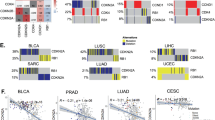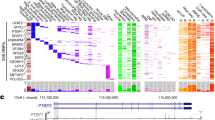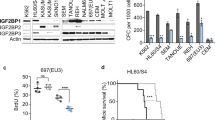Abstract
The human gene (RB) that determines susceptibility to hereditary retinoblastoma has been identified recently by molecular genetic techniques1,2,14. Previous results indicate that complete inactiva-tion of the RB gene is required for tumour formation. As a 'cancer suppressor' gene, RB thus functions in a manner opposite to that of most other oncogenes. Sequence analysis of RB complementary DNA clones demonstrated a long open reading frame encoding a hypothetical protein with features suggestive of a DNA-binding function2. To further substantiate and identify the RB protein, we have prepared rabbit antisera against a trypE-RB fusion protein. The purified anti-RB IgG immunoprecipitates a protein doublet with apparent relative molecular mass (Mr) of 110,000–114,000. The specific protein(s) are present in all cell lines expressing normal RB mRNA, but are not detected in five retinoblastoma cell lines examined. The RB protein can be metabolically labelled with 32P-phosphoric acid, indicating that it is a phosphoprotein. Biochemical fractionation and immunofluorescence studies demonstrate that the majority of the protein is located within the nucleus. Furthermore, the protein can be retained by and eluted from DNA-cellulose columns, suggesting that it is associated with DNA binding activity. Taken together, these results imply that the RB gene product may function in regulating other genes within the cell.
This is a preview of subscription content, access via your institution
Access options
Subscribe to this journal
Receive 51 print issues and online access
$199.00 per year
only $3.90 per issue
Buy this article
- Purchase on Springer Link
- Instant access to full article PDF
Prices may be subject to local taxes which are calculated during checkout
Similar content being viewed by others
References
Friend, S. et al. Nature 323, 643–645 (1986).
Lee, W. H. et al. Science 235, 1394–1399 (1987).
Spindler, K., Rosser, D. & Berk, J. Virology 49, 132–141 (1984).
Boyle, W. J., Lipsick, J. S. & Baluda, M. A. Proc. natn. Acad. Sci. U.S.A. 83, 4685–4689 (1986).
Lee, W. H., Wheatley, W., Benedict, W., Huang, C. M. & Lee, E. Y. H. P. Proc. natn Acad. Sci. U.S.A. 83, 6790–6794 (1986).
Seeger, R. C. et al. New Engl. J. Med. 313, 1111–1116 (1985).
McFall, R. C., Sery, T. W. & Makedon, M. Cancer Res. 37, 1003–1010 (1977).
Tai, T. et al. J. biol. Chem. 250, 8569–8575 (1975).
Comings, D. E. Proc. natn. Acad. Sci. U.S.A. 70, 3324–3328 (1973).
Lee, W. H., Murphree, A. L. & Benedict, B. W. Nature 309, 458–460 (1984).
Radke, K. et al. J. Cell Biol. 97, 1601–1611 (1983).
Ramsay, G., Stanton, L., Schwab, M. & Bishop, J. M. Molec. Cell Biol. 6, 4450–4457 (1986).
Weiss, R., Teich, N., Varmus, H. & Coffin, J. RNA Tumor Viruses (Cold Spring Harbor Laboratory, New York, (1985).
Fung, Y. K. T. et al. Science 236, 1657–1661 (1987).
Author information
Authors and Affiliations
Rights and permissions
About this article
Cite this article
Lee, WH., Shew, JY., Hong, F. et al. The retinoblastoma susceptibility gene encodes a nuclear phosphoprotein associated with DNA binding activity. Nature 329, 642–645 (1987). https://doi.org/10.1038/329642a0
Received:
Accepted:
Issue Date:
DOI: https://doi.org/10.1038/329642a0
This article is cited by
-
Endothelial retinoblastoma protein reduces abdominal aortic aneurysm development via promoting DHFR/NO pathway-mediated vasoprotection
Molecular and Cellular Biochemistry (2019)
-
Non-canonical functions of the RB protein in cancer
Nature Reviews Cancer (2018)
Comments
By submitting a comment you agree to abide by our Terms and Community Guidelines. If you find something abusive or that does not comply with our terms or guidelines please flag it as inappropriate.



